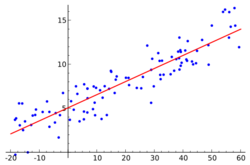Iteratively reweighted least squares
| Part of a series on |
| Regression analysis |
|---|
 |
| Models |
| Estimation |
| Background |
|
|
The method of iteratively reweighted least squares (IRLS) is used to solve certain optimization problems with objective functions of the form of a p-norm:
by an iterative method in which each step involves solving a weighted least squares problem of the form:[1]
IRLS is used to find the maximum likelihood estimates of a generalized linear model, and in robust regression to find an M-estimator, as a way of mitigating the influence of outliers in an otherwise normally-distributed data set, for example, by minimizing the least absolute errors rather than the least square errors.
One of the advantages of IRLS over linear programming and convex programming is that it can be used with Gauss–Newton and Levenberg–Marquardt numerical algorithms.
Examples
L1 minimization for sparse recovery
IRLS can be used for ℓ1 minimization and smoothed ℓp minimization, p < 1, in compressed sensing problems. It has been proved that the algorithm has a linear rate of convergence for ℓ1 norm and superlinear for ℓt with t < 1, under the restricted isometry property, which is generally a sufficient condition for sparse solutions.Cite error: Closing </ref> missing for <ref> tag
where W(t) is the diagonal matrix of weights, usually with all elements set initially to:
and updated after each iteration to:
In the case p = 1, this corresponds to least absolute deviation regression (in this case, the problem would be better approached by use of linear programming methods,[2] so the result would be exact) and the formula is:
To avoid dividing by zero, regularization must be done, so in practice the formula is:
where is some small value, like 0.0001.[2] Note the use of in the weighting function is equivalent to the Huber loss function in robust estimation. [3]
See also
- Feasible generalized least squares
- Weiszfeld's algorithm (for approximating the geometric median), which can be viewed as a special case of IRLS
Notes
- ↑ C. Sidney Burrus, Iterative Reweighted Least Squares
- ↑ 2.0 2.1 William A. Pfeil, Statistical Teaching Aids, Bachelor of Science thesis, Worcester Polytechnic Institute, 2006
- ↑ Fox, J.; Weisberg, S. (2013),Robust Regression, Course Notes, University of Minnesota
References
- Numerical Methods for Least Squares Problems by Åke Björck (Chapter 4: Generalized Least Squares Problems.)
- Practical Least-Squares for Computer Graphics. SIGGRAPH Course 11
External links
 |
